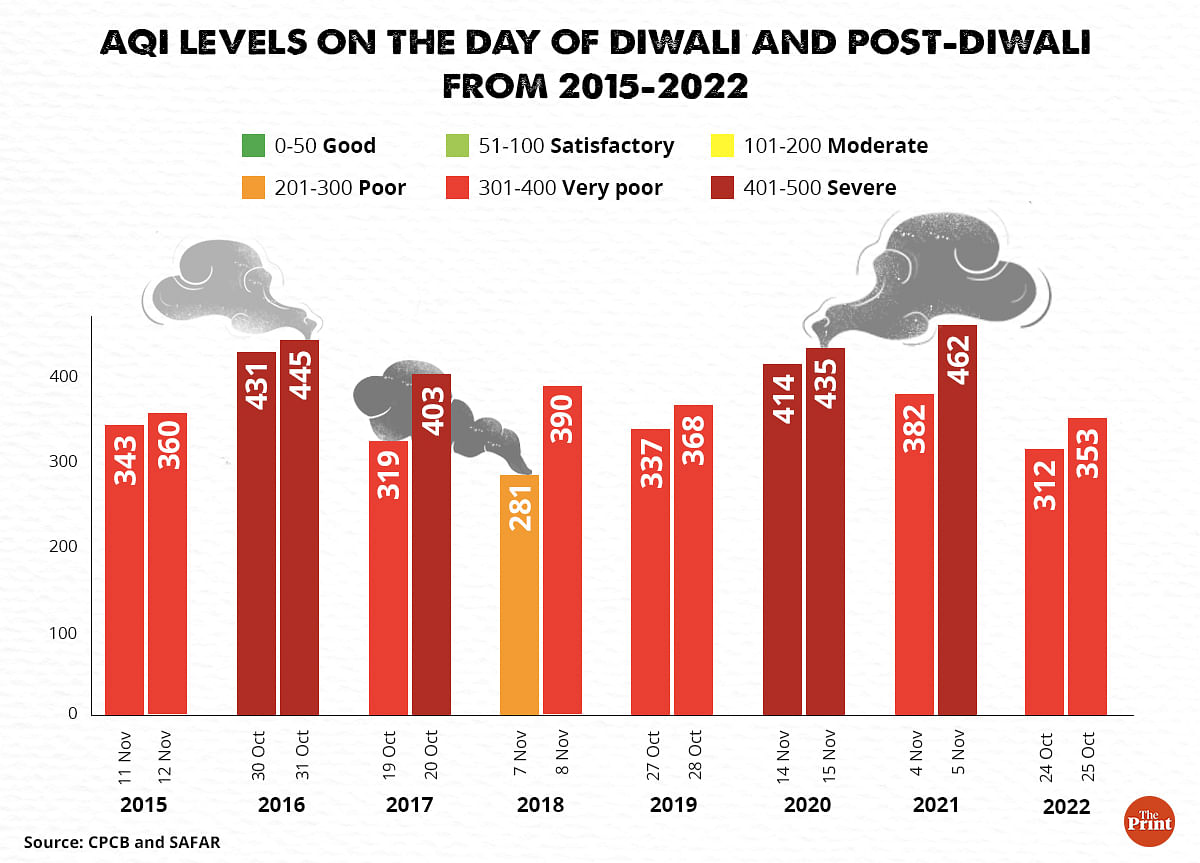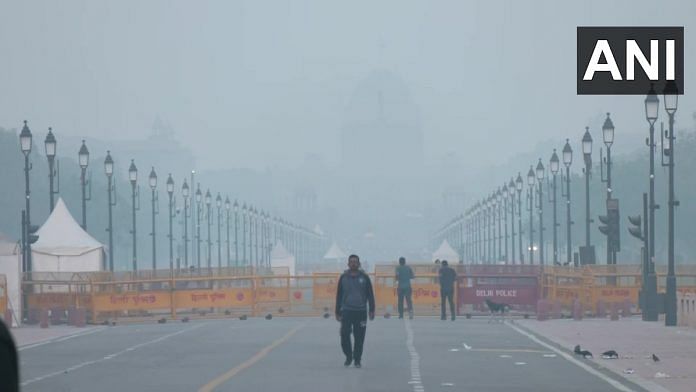New Delhi: Delhi Chief Minister Arvind Kejriwal has been quick to announce the improvement recorded in the capital’s air quality levels compared to the day after Diwali in previous years. This despite the blatant violation of the ban on crackers announced by his government last month.
Tuesday morning at 7 am, Delhi reportedly recorded an AQI level of 326. By 11 am, according to the System of Air Quality and Weather Forecasting And Research (SAFAR), AQI levels had reached 353. This is the lowest since 2015, when AQI levels post-Diwali were recorded at 360.
AQI levels between zero and 50 are considered ‘good’; 51-100 as ‘satisfactory’, 101-200 as ‘moderate’, 201-300 as ‘poor’, 301-400 as ‘very poor’ and 401-500 as ‘severe’. In Delhi, the post-Diwali AQI since 2016 has consistently fallen in the last two categories, touching 462 last year.
Citing air pollution data Monday and Tuesday, Kejriwal showed that pre- and post-Diwali air pollution levels in Delhi were lower compared to previous years, calling it an “improvement” with “encouraging results”.
Some years back, Del was the most polluted city in the world. Not any more!
People of Del worked v hard. Today, we hv improved a lot. Whereas we hv improved, its still a long way. We will continue working hard so that we find a place in the best cities of the world. https://t.co/UTL18dEWP7
— Arvind Kejriwal (@ArvindKejriwal) October 24, 2022
प्रदूषण के क्षेत्र में दिल्लीवासी काफ़ी मेहनत कर रहे हैं। काफ़ी उत्साहजनक नतीजे आये हैं। पर अभी लंबा रास्ता तय करना है। दिल्ली को दुनिया का सबसे बेहतरीन शहर बनायेंगे https://t.co/VVoLxBrGd4
— Arvind Kejriwal (@ArvindKejriwal) October 25, 2022
Kejriwal went on to say that Delhi was no longer among the most polluted cities in the world, citing reports on rankings by the World Air Quality Index, and credited the improvement to Delhi government’s “hard work”.
However, multiple factors play a role in determining the air pollution levels in the national capital — among them, the onset of winter, paddy crop residue burning in the neighbouring states, bursting of crackers during Diwali and meteorological factors such as wind speed and rainfall.
This year, a delay in peak stubble burning incidents and the fact that Diwali fell in October, when temperatures were warmer, helped control air pollution, said Vijay Kumar Soni, head of the environment monitoring and research centre at the India Meteorological Department (IMD).
“It is true that this year pollution levels were lower compared to other years. There are three reasons for this. One is because of warmer temperatures, the height at which the pollution is mixed was higher, so the pollution is easier to disperse. The Graded Response Action Plan (GRAP) also kicked in earlier than previous years, which helped curb vehicular emissions. And lastly, there are far fewer farm fires right now compared to other Diwali days,” he told ThePrint.
The GRAP is a set of measures designed to reduce air pollution emerging from various sources, such as vehicles, industry and road dust. This year the GRAP was implemented at the beginning of October.
However, even as absolute air pollution levels recorded were lower compared to recent years, experts have pointed out that the pattern of air pollution spiking the night of Diwali has remained the same, pointing to gaps in enforcing the cracker ban.
Also Read: Will an ‘early’ October Diwali ensure less air pollution? Data from past 5 years says no
‘Better meteorology, comparatively lower fire counts’
According to the Consortium for Research on Agroecosystem Monitoring and Modeling from Space (CREAMS), an initiative of the Indian Agricultural Research Institute, the country saw 1,519 instances of stubble burning on the day of Diwali, and 7,842 instances since September.
This number is substantially lower compared to Diwali in 2021, which fell on 4 November, when 3,525 fires were detected. By then, over 30,000 instances of stubble burning had taken place since the beginning of the season.
“Early Diwali with slightly better meteorology, comparatively lower fire counts, had lower base pollution compared to the last few years. But firecracker bursting led to a spike similar to 2019,” said Sunil Dahiya, an analyst with the Centre for Research on Energy and Clean Air (CREA).
The #Diwali air quality data from @CPCB_OFFICIAL shows that the #firecracker ban wasn't implemented/enforced in #Delhi as #Pollution levels touched nearly a similar peak to 2019 ~540 µg/m3 despite better meteorology & lower contribution from farm fires#AirPollution #Health https://t.co/efd545mjtV pic.twitter.com/ElYPGeAYEm
— Sunil Dahiya (@Sunil_S_Dahiya) October 25, 2022
“This year, the peak of stubble burning, which is usually between the last week of October and first week of November, will be delayed by seven to 10 days because of unexpected rains,” said a professor at the Punjab Agricultural University, who did not wish to be named.
Delhi and its adjoining areas witnessed heavy rainfall on 3 October, which helped reduce dust levels.
Also Read: State bodies ‘ill equipped’ to handle air pollution in ‘most-polluted’ Gangetic plain, finds study
Diwali AQI across the years
Data from the Central Pollution Control Board (CPCB) shows that in Delhi, air pollution levels have hovered at ‘very poor’ to ‘severe’ levels around Diwali, with the exception of 2018. This Diwali has been no different, even if absolute levels show a minor improvement.
In 2015, 2017, 2019 and 2021, air pollution levels were ‘very poor’ on the day of Diwali and either stayed in the same category or further deteriorated to ‘severe’. The only exception was in 2018, when air pollution levels were at ‘poor’ on Diwali and plunged to ‘very poor’ the day after.
In 2020 and 2016, air pollution on Diwali and the day after was at ‘severe’.

An analysis by independent research group Urban Emissions shows that this year at 17.6 per cent on the day of Diwali, the biggest source of air pollution in the city was open fires from biomass burning, followed by road dust (15.4 per cent) and industrial activity (14.8 per cent). The day after Diwali, on 25 October, the contribution of open fires from biomass to air pollution went up to 27.1 per cent.
(Edited by Theres Sudeep)
Also Read: You thought only winter meant bad air in Delhi? Govt data tells a different, worrying story



